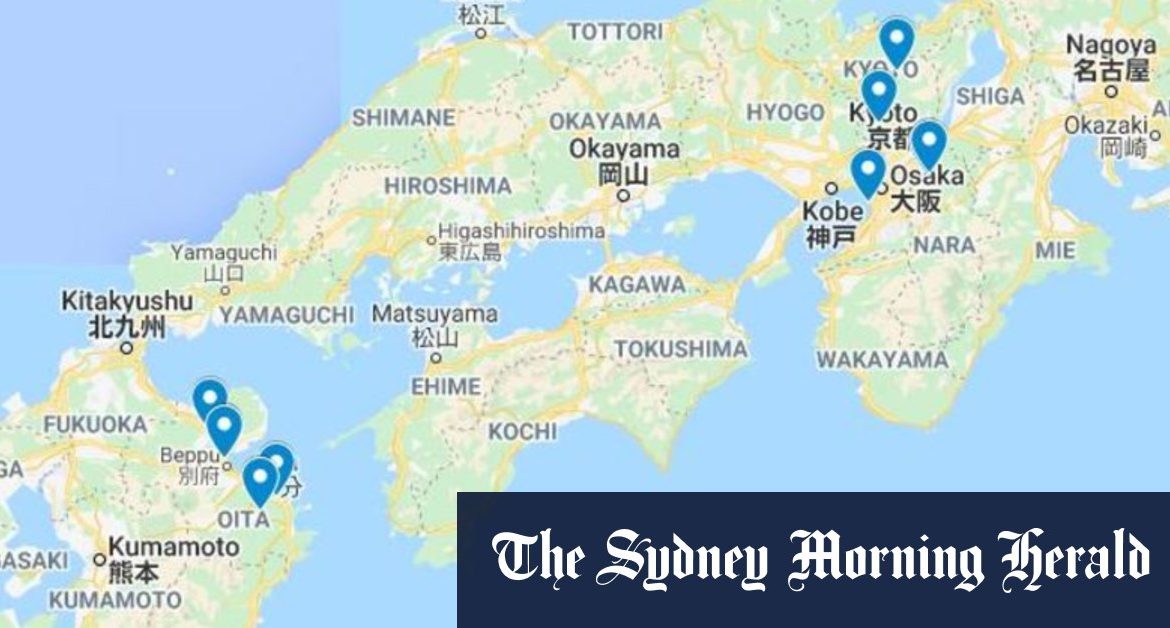The Suikei-en Garden is a must-see for travellers wanting to enjoy the traditional scenery created by Japanese landscaping techniques which have continued to the present day.
The beautifully vibrant Keihanna Commemorative Park in Seika Town.Credit: Supplied.
Kyoto is about less tangible culture too. On December 4th, 2013, washoku or Japanese food was registered as a UNESCO intangible cultural heritage.
A kaiseki meal at Suigetsu restaurant, located near JR Hōsono Station in Seika Town, features a gorgeously plated series of high-end dishes served in a tatami room overlooking a courtyard garden. Before entering Suigetsu, each guest is subject to a temperature check, and seating is arranged to ensure an appropriate distance between customers to prevent the spread of COVID19.
Ancient handicrafts flourish, whether you’re after lacquerware, textiles or traditional dolls. Visit Swordsmith Yuya Nakanishi of Kameoka City and you can learn how samurai swords are made.

Swordsmith Yuya Nakanishi of Kameoka City hard at work.Credit: Supplied.
If getting a taste of the landscape is on your to-do list, don’t miss Kyoto’s splendidly hilly countryside. Stay in Yamazato Ryori Ryokan Isobe, a traditional-style thatched inn located in Natan City, to enjoy hearty seasonal inaka or countryside meals, and to soak up rural Japan’s tranquillity.
From the nearby ports of Osaka or Kobe, take the Ferry Sunflower south on an overnight journey that saves on accommodation costs and sails the picturesque Inland Sea. The ferry transports you to Kyushu, Japan’s southernmost large island, noted for its stunning landscapes, warm climate and laidback smaller cities.
To prevent the spread of COVID19, the Ferry Sunflower conducts body temperature measurements and health checks on all passengers prior to boarding. Any passengers who do not comply with these guidelines are refused boarding.
Oita is a great base for exploration. Stay at the new ANA InterContinental Beppu Resort & Spa which has terrific bay views and its very own onsen, or hot-spring baths.
Alternatively, opt for nohaku or homestay experience to immerse yourself in the rural life of Japan in various landscapes. Now commonly known as green tourism, the Ajimu Farm stay experience beyond town is one of 280 different homestay locations in Oita, where the Tokieda family will introduce you to life amid the fields for a change of pace from Japan’s big-city excitement.

The Ajimu Farm stay experience.Credit: Supplied.
Just along the coast from Oita is Beppu, renowned for its abundant hot springs, boiling with orange, brilliant blue or milky-white mud. These steaming jigoku or “hells” make for a spectacular sight, but other volcanic springs are at just the right temperature to feed dozens of onsen for a relaxing float and age-old Japanese experience.
Visitors flock here from all over Japan, so Beppu also has a lively bar and nightlife and abundant restaurants where you can tuck into ramen noodles and excellent local seafood.
For something different, head to Usuki for Shojin Cuisine, also known as Buddhist vegetarian food at Seigetsuan.

A delicious vegetarian meal at Seigetsuan in Usuki.Credit: Supplied.
While in Usuki, check out the small workshops making Usuki-yaki, a revived form of pottery which makes for a great souvenir to remind you of the regions’ many charms.







